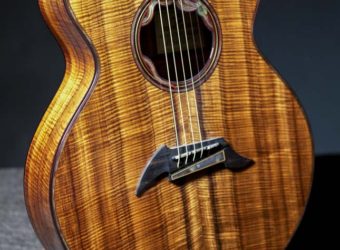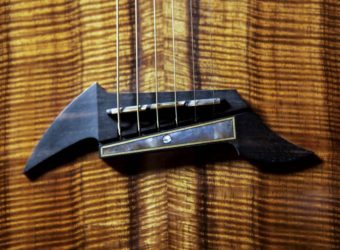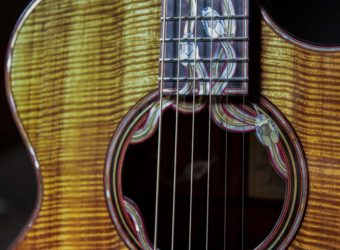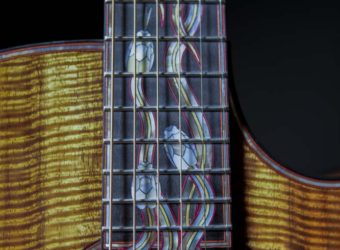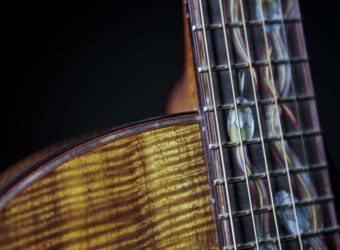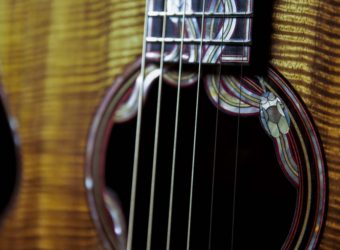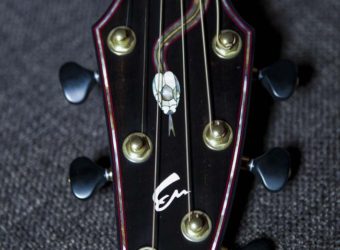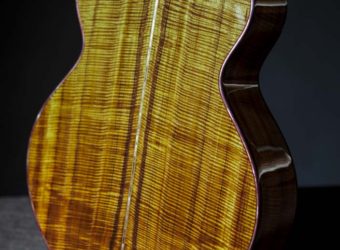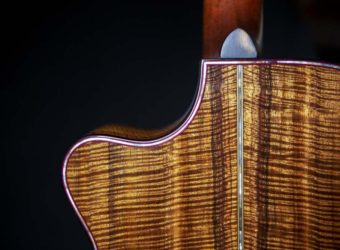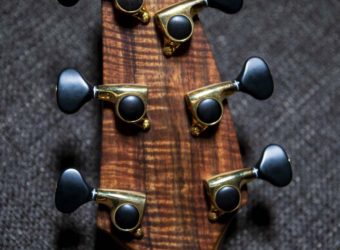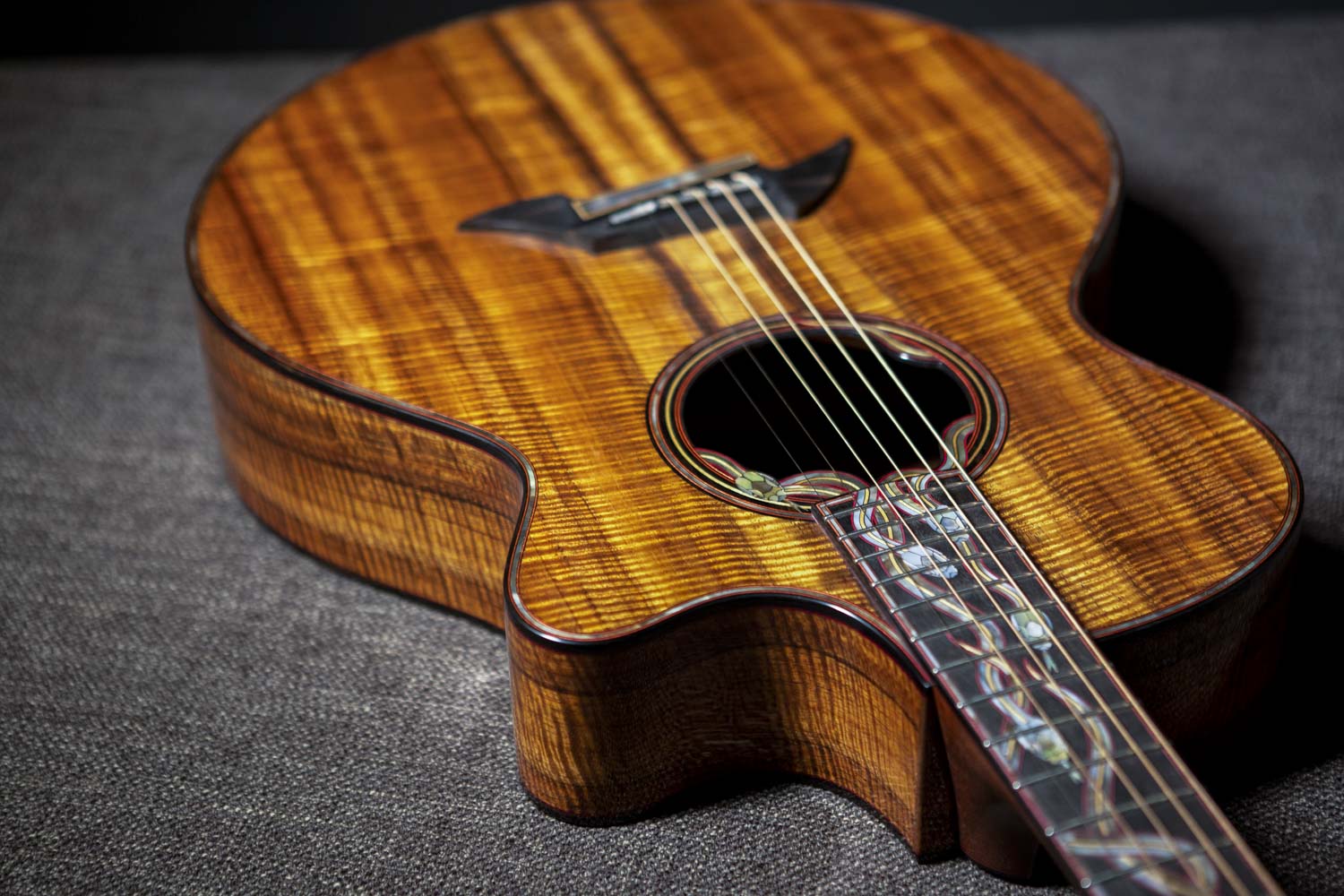
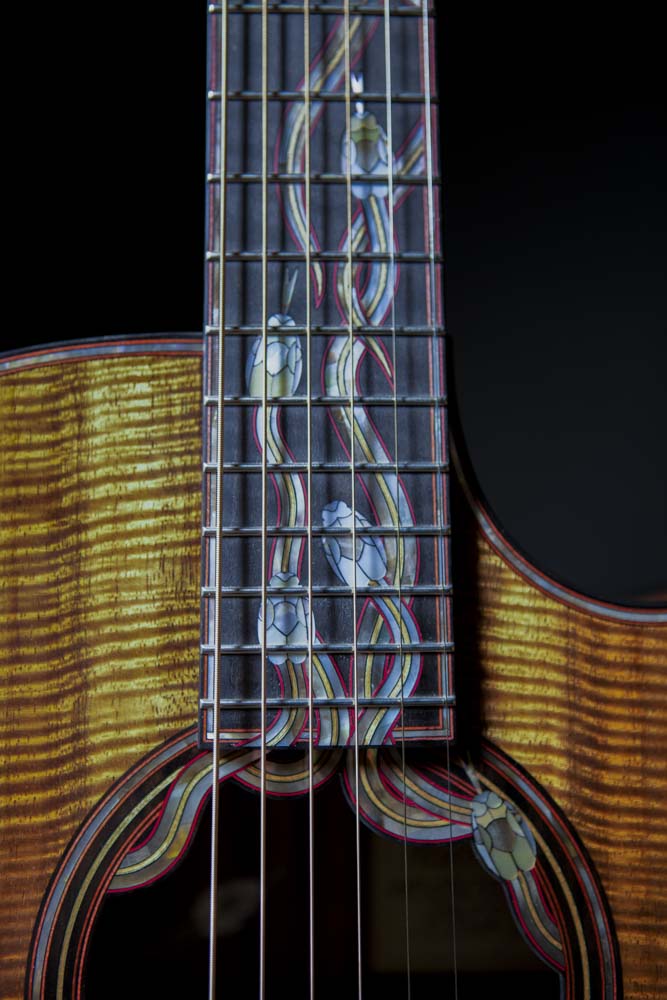 Kim Breedloves’ stunning snake-laced masterpiece still inspires with its care, dedication and passion.
Kim Breedloves’ stunning snake-laced masterpiece still inspires with its care, dedication and passion.
“This is the one. I would call this Kim Breedlove’s masterpiece,” says Angela Christensen.
The “one” in question is Exodus, as stunning an instrument as you are ever likely to see, not least because of its shimmering, hypnotic, “retirement grade” all Hawaiian koa body.
Normally wood this naturally beautiful would be dubbed presentation grade, but as Christensen, who heads product development and wood management for Breedlove, notes with a laugh, it was called retirement grade because the purveyor of this heart-stopping find “could live a long time off that one log.”
“It’s pretty amazing stuff” she affirms. “There’s not been another tree like it.”
“The color variation is phenomenal. It goes through the entire range of koa shades, from very light, golden hues to rich browns with a little bit of red, all the way to really dark line contrasts. The figure is obviously just incredible. It’s got everything.”
With a $75,000 price tag, Exodus—housed along with a few other select treasures in a dedicated display case at Breedlove’s Bend, Oregon offices—is a retirement grade proposition on its own.
Breedlove owner Tom Bedell keeps the instrument close at hand to remind all of its legacy.
“It still inspires us every day,” he says. “The care, dedication and passion that went into this guitar leads us in the right direction.”
Spend some time peering at it, getting lost in the magical grain, imagining that exquisite, ringing, yet warm koa voice, and you’ll understand that masterpiece might even be an understatement.
Before he started building banjos with Greg Deering and Geoff Stelling in the 1970s, Kim Breedlove already had a serious background in art—with a degree embracing drawing, painting and graphic design—much less before he started building guitars in Oregon with his younger brother Larry and partner Steve Henderson, who had formed the eponymous company in the early 90s.
By 2007, when Exodus was completed, Kim had pushed the boundaries of modern inlay to new heights.
Exodus, part of a loosely delineated Private Reserve program, is defined by its intricate motif, which features nine snakes slithering out of the instrument’s sound hole, gliding up the neck to a new day.
Bedell says, “As a child in San Diego, Kim was walking along a sunny cliffside and witnessed a hatch of baby snakes making their way out of a hole in the rock—an exodus. That image stayed with him his entire life.”
The snakes actually begin in shadow, inside the koa back, emerging from under Honduran mahogany braces, which were cut by Christensen, who also bent the sides and installed the Sitka spruce top braces and mahogany blocks.
“You have to do that inner body inlay at the beginning of the process,” says Christensen, who studied under Breedlove, but brought her own education and experience in woodworking, metalsmithing and stonework to the shop, adding, with wonder, “Even before you put the braces on the back, it has to be right.”
As the snakes loop out of the body, the true Zen artistry of Breedlove’s work is revealed.
“Kim hand cut the irregular lines of the sound hole, and the way it is bound around the image is just magnificent. The craftsmanship and execution is so perfect.”
As the reptiles travel up the neck, they twine beneath the frets, but also merge and veer with similarly appointed red and yellow fiber purfling, crossing over the ebony binding that ties the entire instrument together right down to a snakelike back strip. It’s a dance of dramatic materials, genuine vision and precision crafting.
“It’s such a beautiful layout of these different shapes intersecting all over the canvas of the fretboard, the headstock and the body,” says the still awestruck Christensen. “As soon as you get close enough to observe detail, you can see that each individual piece of abalone is hand-cut. The way the fretboard extension aligns with the rosette; the way the lines curve so gracefully … I know from experience that all of that took unbelievable skill and patience. The transitions are remarkable.”
Christensen chuckles again at a specific memory of her mentor, who retired a few years ago.
“I remember tireless hours of Kim just sitting at his bench, jewelry saw in hand, wearing two pairs of glasses, like a Renaissance scholar. He was happiest in his studio, and you could tell Exodus was purely a labor of love for him. He was really enjoying the challenge he’d given himself, diving into it and losing all track of time.”
Christensen didn’t. She estimates Exodus required 100 plus hours of hand labor, over four times the work of other high end, finely appointed instruments.
And, she says, “Every hour was worth it.”
Exodus, 15.6” across its belly, is a shallow body, soft cutaway auditorium size guitar, 4” deep at the tailblock. Like other Breedloves of its era, it retains the bridge truss, an apparatus left behind when Sound Optimization® superseded its purpose, resulting in even more responsive, tonally superior guitars. Unlike others, even the face of the truss, unseen deep within the body, is hidden behind a slip of the same curly koa that illuminates the rest of the instrument. The same goes for the back of the headstock, topping a 25.5” scale mahogany neck, and girded with ebony-buttoned gold Gotoh tuners.
Ever diligent, Breedlove saw to every detail of Exodus. A trapezoidal black pearl inlay in the winged ebony bridge, for example, ties in visually with the 1&3¼” abalone nut and the carefully laminated ebony and mother of pearl saddle.
He knew, it seems, that this was his masterpiece— a memory of a childhood summer come to life in musical form, forever.
